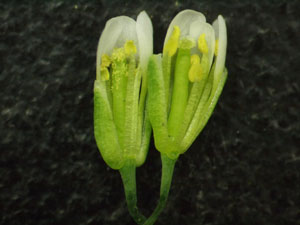Mar. 31, 2017 Research Highlight Biology
Protein study brings sweet success
A protein family that transports sugar to various parts of plants also ferry a vital plant hormone
 Figure 1: Delayed anther development in sweet13 sweet14 mutant flowers (right) results in the absence of pollination, which occurs normally in control flowers (left). © 2017 Mitsunori Seo, RIKEN Center for Sustainable Resource Science
Figure 1: Delayed anther development in sweet13 sweet14 mutant flowers (right) results in the absence of pollination, which occurs normally in control flowers (left). © 2017 Mitsunori Seo, RIKEN Center for Sustainable Resource Science
Two members of a protein family known for their roles in shuttling sugar around plants are also involved in the transport of a vital hormone, a team of researchers at RIKEN find1. This discovery provides a new glimpse into the complex physiological processes of plant development. It also promises to give scientists more control over such processes.
Plants need both sugars and hormones to survive and thrive, but the very different molecular structures of sugars and hormones generally mean that they are associated with distinct proteins.
Now, a team led by Mitsunori Seo at the RIKEN Center for Sustainable Resource Science has discovered an exception to this rule. By expressing two proteins from the family of SWEET proteins—so named because they transport sugars—in yeast and egg cells in culture, Seo and his co-workers found that the proteins also transport gibberellin, a plant hormone that both regulates growth and affects various developmental processes.
Seo and his team discovered that the SWEET proteins AtSWEET13 and AtSWEET14 are found throughout the plant Arabidopsis, being particularly prevalent in the stems, roots, leaves, seeds and anthers (sac-like structures that produce pollen).
The scientists also found that mutant plants in which the genes encoding the two proteins were removed have less transport of gibberellin. Using these mutant plants, they showed that the transporters are essential for many aspects of plant growth and development. In particular, the anthers of the mutant plants showed developmental defects resembling those in gibberellin-deficient plants; these defects resulted in reduced pollination (Fig. 1). However, the same plants responded positively to gibberellin during seed development, germination and growth. “This suggests that AtSWEET13 and AtSWEET14 can regulate gibberellin-mediated physiological responses positively and negatively depending on when and where they are expressed,” explains Seo.
SWEET proteins are very versatile, exhibiting diverse functions in transporting a range of sugars to various parts of a plant, from developing seeds to roots and leaves. The finding that these proteins can also interact with gibberellin adds another dimension to this multifunctionality. “It is interesting to think about how the multifunctionality of SWEET proteins has evolved,” comments Seo.
As well as revealing more about the complex physiological processes involved in plant growth and development, the findings of the study have important practical applications. “Since gibberellin regulates many physiological processes, including seed germination, plant growth and flowering, regulation of SWEET function in plants would allow us to precisely control such physiological processes,” notes Seo.
Related contents
References
- 1. Kanno, Y., Oikawa, T., Chiba, Y., Ishimaru, Y., Shimizu, T., Sano, N., Koshiba, T., Kamiya, Y., Ueda, M. & Seo, M. AtSWEET13 and AtSWEET14 regulate gibberellin-mediated physiological processes. Nature Communications 7, 13245 (2016). doi: 10.1038/ncomms13245
